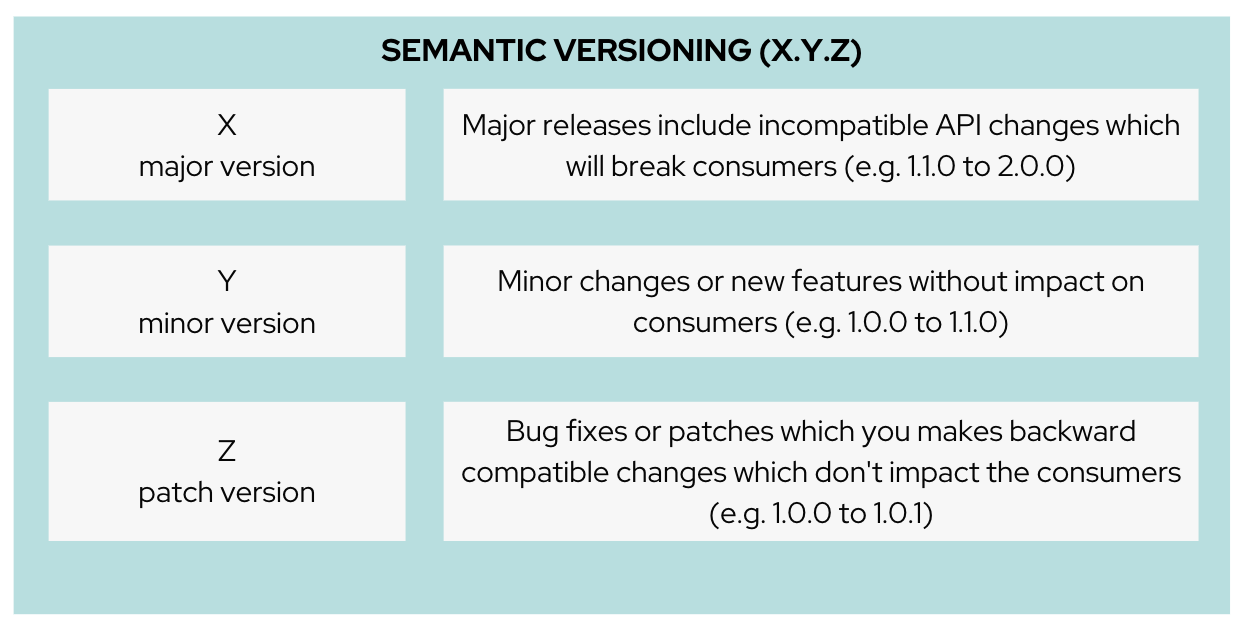Solution Pattern: API Versioning
Architecture
1. Common Challenges
Introducing changes in APIs have an impact across different stakeholders in an API’s lifecycle. Some common challenges are:
As an API Provider |
As a backend Developer of API services |
As an API Consumer |
|
|
|
2. Technology Stack
-
Red Hat technologies
-
Other open source technologies
3. An in-depth look at the solution’s architecture
This Solution Pattern, as discussed earlier, involves the OrderPlacement API which is already in use and needs to undergo the following series of changes.
-
Change 1: A non-breaking change:
-
Introduction of an optional field called
Delivery Instructionswhich the customers can use to provide additional info to help with easy delivery
-
-
Change 2: A breaking change:
-
Moving away from First and Last names as separate fields, to a Full Name field to make it easy for consumers to place orders to represent different cultures and conventions.
-
3.1. When to version
-
Don’t change API versioning frequently. Consumers need a stable versions, and so don’t version often
-
In fact, frequent versioning is seen as chaotic, disorganised
-
Breaking changes should only be considered when there is no other alternative (security/compliance/law) or it becomes uneconomical
-
It is good practice to consider a predictable versioning of APIs (e.g. new versions every 3 months)
3.2. How to version
-
Follow Semantic versioning (semver) to ensure standardisation
The extent of changes to an API (or sofwatre for that matter) drives the versioning by assigning either unique version numbers in the form X.Y.Z.

Click to view text version
(X represent major version, Y minor verson and Z patch version) * Increment X: Major releases include incompatible API changes which will break consumers (e.g. 1.1.0 to 2.0.0) * Increment Y: Minor changes or new features without impact on consumers (e.g. 1.0.0 to 1.1.0) * Increment Z: Bug fixes or patches which you makes backward compatible changes which don’t impact the consumers (e.g. 1.0.0 to 1.0.1)
|
https://semver.org/ provides fantastic guidance on dos and donts of versioning and is a highly recommended read. |
3.3. Different API Versioning Strategies
Here are some common types of API versioning:
Note: These strategies apply when a new API version is applied to the same API Product to handle different versions
-
URL Versioning: Include the API version as part of the URI
Format:
api.globex.com/v1/OrderPlacement
api.globex.com/v2/OrderPlacement-
Endpoint versioning: Different endpoint for each API version
Format:
api.globex.com/orderplacement_v1
api.globex.com/orderplacement_v2-
Custom header versioning: Use a header (that is, "x-api-version") to specify the version.
Format:
Header: x-api-version v1
Header: x-api-version v2|
|
3.3.1. A different approach to API versioning
An alternate way to implement API versioning is to create a completely new API product for a new API version. Sometimes this could be the right way to go. With this approach - especially for breaking changes
-
Consumers can intentionally start adopting a new API and do all the changes testing and rolling out a new version of their software
-
API providers can easily understand how many consumers are still using a particular version without having to do a lot of details analytics
-
Sunsetting an API product can be easier because there an entire API product can be archived after consumers migrate away to the newer version
3.3.2. When to choose what
The answer is, of course, it depends :)
Usually the popular approach is URL versioning, and that is what we will discuss in this pattern. Whichever method you opt for, a majority of this pattern will still be helpful in thinking through impact on the stakeholders.
3.4. Measure and manage adoption
There will be a point when API versions or perhaps the API itself will need to be sunset. It is important to plan for this from the initial stages.
-
Track consumption of API versions to understand usage of APIs and versions. The API management platform should be able to provide the necessary metrics to do this.
-
Set clear predictable timelines on when consumers can expect new API versions.
-
e.g. Patch versions every month; Minor or major versions every 3 months.
-
Publish these policies and guidelines on the developer portal so that consumers can manage their development cycles
-
-
Notify consumers about new API versions being available; and more importantly notify consumers about adopting newer versions, and sunsetting of older versions.
-
You will need to define frequency of how often to notify consumers depending on your business needs.
-
Note that maintaining multiple versions is a burden on providers because of the quantum of effort needed to support older versions till they are completely removed.
-
-
Release notes in the Developer Portal should clearly articulate changes in each version, along with examples and a way to try out.
-
This should include a Changelog of all updates and versions the API goes through.
-
4. More about the Technology Stack
4.1. API Design, Govern and Mockup
-
As part of the API-First approach, the first step, of course, is to design the APIs. API Designer is a tool to design your APIs used by various stakeholders to define the API specs.
-
Once the API design is complete, the API versions can be published in a schema registry. Red Hat build of Apicurio Registry is a datastore for sharing standard event schemas and API designs across event-driven and API architectures.
-
You can upload new artefacts, new versions, view the metadata, download the specs, view documentation and view the content as well.
-
Through Content rules one can validate new versions of the APIs against the existing specs to ensure validity and backward compatibility.
-
-
Microcks can be used to mock the APIs so that the various development teams can to develop their pieces of code even before the APIs are completely implemented
These stages have been already discussed in the Manage and Secure APIs with an API First Approach. Please refer to this pattern to learn more about these stages.
4.2. Red Hat 3scale API Management
Let’s look at a quick refresher on 3scale API management and it’s various entities
Click to text version of the below diagram
-
An API in 3scale is referred to as a Product. Products can have one or many Backends.
-
A Backend is a web service that 3scale will proxy requests to based on mapping rules defined by the Product.
-
Application plans can be used to define usage rules and limits for your API.
-
A developer signs up to an Application Plan of a API Product; A a unique Application is associated a unique set of credentials for the API,
-
Method defines the allowed interactions - such as GET, POST or DELETE - with an API or a product
-
Mapping rules define the metrics or methods that you want to report depending on the requests to your API.
-
Metrics help you track of specific calls to an API

We use the managed Red Hat 3scale API Management platform here to publish, manage and secure the backend APIs.
Each API can be configured to be secured using a number of ways. In this case, the APIs are secured with an API key which should be passed through http request header. 3scale allows you to have various application plans. Developers can subscribe to those APIs and can access APIs through an assigned API key securely. You can monitor the APIs and also track usage
As a developer, you would like to build functionality around the APIs. There is also a Development Portal which is currently under, well, development. You can sign in as a developer here. This developer has already subscribed to the API and is given an API key which should be used in all API calls to ensure the calls are authenticated by the API management platform.
The devportal allows viewing Live documentation as well, which is another view of the OpenAPI specs. Developers can try it out to see what kind of responses they can get back. The developers can also view statistics for their account in a graph format
4.3. GitOps and ArgoCD
GitOps with ArgoCD provides an efficient way of performing API management. GitOps makes it easy for product managers, developers, operations, and security teams to work together in API management.
Read more about this here